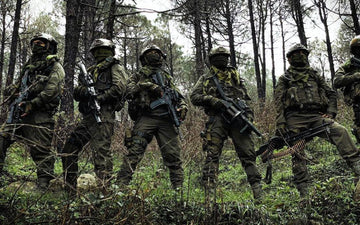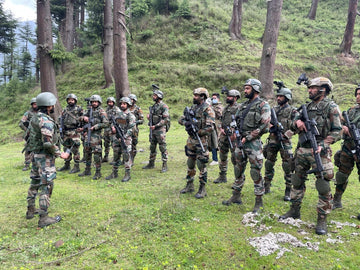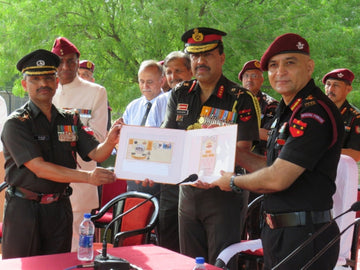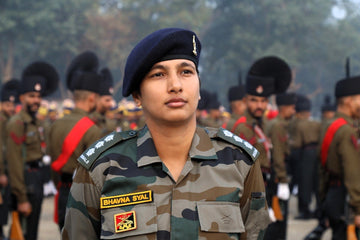The Shatrujeet Brigade, officially known as the 50th Independent Parachute Brigade, is a distinguished formation within the Indian Army, renowned for its elite airborne capabilities. Established during World War II, this brigade has a rich history marked by valor and significant contributions to India's military operations. This article delves into the origins, structure, operational history, and current role of the Shatrujeet Brigade, providing a comprehensive overview of its importance in the Indian defense landscape.
Historical Background
Formation and Early Years
The Shatrujeet Brigade was formed in October 1941, initially as part of the British Indian Army. Its establishment was a response to the growing need for specialized airborne forces during World War II. The brigade's first major engagement was the Battle of Sangshak, where it played a crucial role in delaying Japanese advances towards Imphal. This operation showcased the brigade's capability and set the stage for its future endeavors.
Name Significance
The name "Shatrujeet" is derived from a character in ancient Indian texts, symbolizing victory over enemies. This name reflects the brigade's ethos and commitment to overcoming challenges in combat situations. The brigade's insignia, featuring a dagger, further emphasizes its readiness for swift and decisive action.

Structure of the Brigade
Composition
The Shatrujeet Brigade is composed of several key units, each contributing to its operational effectiveness:
- Airborne Battalions: The brigade includes two primary airborne battalions, which are trained for rapid deployment and specialized operations.
- Special Forces Battalion: This unit focuses on unconventional warfare, counter-terrorism, and special reconnaissance missions.
- Artillery Support: The brigade is supported by the 9th and 17th Para Field Regiments, providing essential firepower during operations.
- Medical and Engineering Units: The 60th Para Field Hospital and the 411th Para Field Company ensure medical support and engineering capabilities, respectively.
Command Structure
The brigade operates under the command of a Brigadier, who oversees its various units and coordinates operations. The headquarters is located in Agra, India, serving as the central hub for planning and executing missions.

Operational History
Key Engagements
The Shatrujeet Brigade has participated in numerous significant military operations since its inception. Some of the most notable engagements include:
-
Indo-Pakistani War of 1947-48: The brigade played a pivotal role in the Kashmir conflict, with its battalions actively involved in securing key territories. Brigadier Mohammad Usman, the brigade commander, was martyred during this conflict and posthumously awarded the Maha Vir Chakra for his bravery.
-
Annexation of Goa (1961): The brigade was instrumental in the swift operation to annex Goa from Portuguese rule. Its units were among the first to reach Panjim, overcoming obstacles with remarkable speed and efficiency.
-
Indo-Pakistani War of 1971: During this conflict, the brigade executed airborne operations that significantly contributed to the liberation of Bangladesh. The 2nd Battalion was notably dropped at Tangail, facilitating rapid advances into enemy territory.
-
Operation Cactus (1988): In response to a coup attempt in the Maldives, the Shatrujeet Brigade was deployed to restore order. The operation was executed with precision, showcasing the brigade's capability in international crisis response.
-
Kargil War (1999): The brigade's involvement in the Kargil conflict highlighted its role in high-altitude warfare. Elements of the brigade were deployed in the Mushkoh Valley, where they earned commendations for their performance.

Current Role and Capabilities
Modernization and Training
In the 21st century, the Shatrujeet Brigade continues to evolve, incorporating modern warfare techniques and technologies. The brigade undergoes rigorous training exercises, including joint drills with international forces, to enhance its operational readiness. Recent exercises, such as the Maroo Strike, involved airdropping mechanized vehicles and combat loads, demonstrating the brigade's adaptability to contemporary combat scenarios.
Humanitarian Assistance and Disaster Relief
Beyond combat operations, the Shatrujeet Brigade also plays a vital role in humanitarian assistance and disaster relief missions. Its rapid deployment capabilities enable it to respond effectively to natural disasters, providing medical aid and logistical support to affected regions.
Challenges and Future Prospects
Operational Challenges
The Shatrujeet Brigade faces several challenges, including the need for continuous modernization and the integration of new technologies. As warfare evolves, the brigade must adapt to emerging threats, including cyber warfare and asymmetric conflicts.
Future Directions
Looking ahead, the Shatrujeet Brigade aims to enhance its capabilities through advanced training programs and strategic partnerships with allied nations. The focus will be on maintaining operational readiness while fostering a culture of innovation and resilience within its ranks.
Conclusion
The Shatrujeet Brigade stands as a testament to the valor and dedication of the Indian Army. With a storied history and a commitment to excellence, this elite formation continues to play a crucial role in safeguarding national security and responding to global challenges. As it evolves to meet the demands of modern warfare, the Shatrujeet Brigade remains a symbol of pride for the nation and a formidable force on the battlefield.





